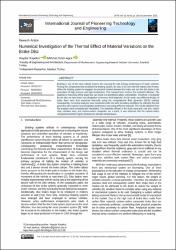Numerical Investigation of the Thermal Effect of Material Variations on the Brake Disc
Özet
Braking is one of the most critical systems for ensuring the safe driving performance of motor vehicles.
Among the components that constitute the braking system, the disc is the one with the highest risk of wear.
When the braking system is engaged, the physical contact between the brake pad and the disc leads to the
generation of high pressure and high temperature. This released heat shortens the material's lifespan. The
wearing or fracturing of the brake disc can result in a significant safety vulnerability. Therefore, it is desired
for the discs to have better heat dissipation to increase their longevity. In this study, two different designs of
brake discs were first examined thermally using the computational fluid dynamics (CFD) method.
Subsequently, numerical analyses were conducted under the same boundary conditions by selecting the disc
geometry with superior heat dissipation performance and using different materials. The results obtained from
the analyses were compared and interpreted. The materials utilized in the study were grey cast iron, carbon
steel, stainless steel, and carbon-carbon composite. As a result, it was observed that the carbon-carbon
composite exhibited higher resistance to elevated temperatures.

















